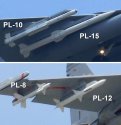in *my* opinion, guided bombs aren't about CAS. They're about cost effective destruction of fixed or relocatable (but not mobile) targets. Which in *my* opinion form something like 90% of all targets in all missions. And for me it is very weird that plaaf, which has specialized planes like jh7, and in the future j16, that will train almost exclusively for ground strike missions, purposefully chose not to be able to engage such targets in a cost efficient way. KD88 is fine, but it can't do all the jobs (lacks the punch and penetration) and what jobs it can do - it can't do for the same pricetag compared to a simple satnav bomb. There's also a matter of targeting. KD88 is meant to engage far away targets. Or fixed targets. A plane with a targeting pod can engage other targets as well.
q5 was always something of a dinosaur, not just tech wise but doctrine wise. to fly over the front line, go very low and drop dumb bombs or fire rockets onto the enemy. adding lt-2 helped a little in its mission range but realistically it wouldn't profit much from modern bombs and missiles (except for a maverick type missile which PLAAF also lacks) Q5 was always a pure CAS plane as its too short legged and vulnerable to go beyond the front line.
But like i said, there are a bunch of targets beyond ones on the frontline. Artillery, tanks and other platforms can provide support on the front line. But interdiction of enemy supply lines? Reinforcements? Supply depots? Infrastructure targets? Bases and so on? They all require a cheap means of destruction, and satellite guided bomb is cheapest way to go about it. With modern jammers, with j10 and j16 in ever increasing numbers, there is no reason those planes and even jh7 can't go deeper in certain missions and destroy those targets. Sometimes enemy defenses will be too powerful. But missions are usually planned to go after target sets that are achievable. Even US couldn't count on being able to defend all its assets at once with such air defenses that deeper strikes would be a no-go. Not to mention other possible adversaries.
I understand Blitzo's position and it may very well be how PLAAF sees it. I just think, if that indeed is the case, it will be better for PLAAF to change it within years, as foundations for it are there. Maybe it's only a matter of political inertia.
Just for the record, I'm not saying that direct attack PGMs are only about CAS. However I do think they are a meaningful part of their utility. I agree that the ability to destroy targets with relative cost effectiveness is a big part of direct attack PGMs which is probably the biggest use of them in modern warfare.
However, that cost effectiveness comes at a risk, which is putting your launch platform within a relatively close range of your target, which may be defended by IADS and CAP.
For the PLAAF, I think until recently the very idea that they could compete with their likely opfor's fighters and to defend their own airspace took the biggest priority, and the idea that they could even try to conduct any direct attack PGM missions, which would inevitably necessitate getting past the opfor's own CAP and IADS, was laughable.
In other words, for any air arm to want to be able to conduct direct attack PGM missions against an opposing force's ground target, they need to optimally achieve two things:
1: air superiority over the enemy's air forces
2: SEAD/DEAD of the enemy's ground based IADS
In the near future I think the PLAAF will have their hands full with those two things, with all the R&D, procurement and training that goes with it. Procuring direct attack PGMs, targeting pods, and integrating them and training with them as part of their striker fighters' routine weapons suite without first having a credible chance of attaining 1 and 2, IMO would very much be putting the cart before the horse.
From there, I think we can kind of see why their emphasis on stand off munitions makes a lot of sense. On the one hand, they're obviously not as cost effective as DA PGMs, nor are they provide as "assured" of destruction of the target as DA PGMs... but on the other hand it allows them to still have the ability to strike at some of the opponent's ground targets while putting their launch platforms at far lower risk or at least reducing the distance they need to cross.

